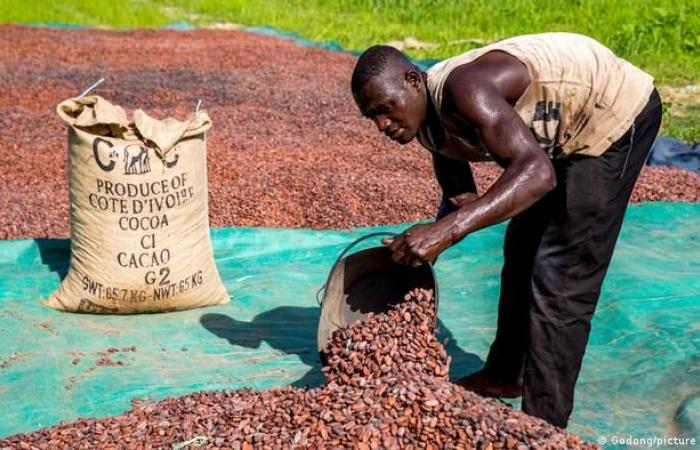Deutsche Wellei
Deutsche Welle https://istoe.com.br/autor/deutsche-welle/
03/27/2024 – 17:31
The value of the chocolate raw material tripled in a few months, surpassing the price of copper. This would be expected to reduce widespread poverty among cocoa farmers. But it’s not that simple. Cocoa prices have risen to unprecedented levels in recent months: recording records as the commodity’s value soars. This Tuesday (26/03), the product reached a value of 10 thousand dollars per metric ton, making it more expensive than copper, which is currently traded at around 8,700 dollars per ton.
The current price of cocoa contrasts sharply with that of a year ago, when the price of the commodity was below 3 thousand dollars.
The dynamics of the cocoa market reveal some worrying aspects, as the current explosion does not bring benefits to all parts of the business. Cocoa farmers, for example, have been trapped in poverty for years, unable to survive on their labor alone. Reports of malnutrition and child labor are frequent in the sector. The hope is that higher cocoa prices will at some point alleviate this situation.
Another problem is the disproportionate concentration of production, with Côte d’Ivoire and Ghana collectively accounting for almost two-thirds of global cocoa production.
What makes prices go up?
The current spike in prices is due to substantial crop failures in these important producing regions, according to Friedel Hütz-Adams, a cocoa specialist at the Südwind Institute in Bonn, Germany. “At the moment, it is estimated that the harvest in Côte d’Ivoire and Ghana has decreased by at least a third,” he tells DW.
The expert describes the situation as a “catastrophic mix” of climate events. The El Niño phenomenon, aggravated by local environmental factors, exacerbated the problem of poor harvests. Hütz-Adams also highlights that deforestation intensifies the effects of El Niño in the region, leading to prolonged periods of rain or drought that harm cocoa production.
Furthermore, the financial constraints faced by many cocoa farmers worsen the situation, making them powerless in the face of agricultural challenges. “In Ghana, for example, last year, it didn’t rain in many regions at first and then it rained for so long that the cocoa trees were submerged in water for a long period, which led to the spread of diseases in the fruits.”
The European Union (EU) has emerged as a key player in the cocoa market. The bloc is the largest consumer in the world, being the destination for approximately half of world production. The United States comes close behind as the second largest consumer. Cocoa producers receive only a fraction of the sector’s income, with the majority of profits going to manufacturers and traders, based in Europe and the USA.
Of every euro spent on a chocolate bar, only about seven cents goes to cocoa farmers, while manufacturers and traders receive about 80 cents, according to Germany’s Ministry for Economic Cooperation and Development (BMZ).
Betting on the future
To mitigate the risks associated with fluctuating cocoa prices, chocolate manufacturers engage in what are called futures trading – that is, they negotiate purchase contracts at a future date and for a pre-defined price. This way, they secure the cocoa beans well before harvest.
However, this practice often leaves farmers vulnerable as their crops are sold at lower prices before prices rise. Farmers in Côte d’Ivoire and Ghana, for example, sold 80% of their production as early as October last year, even before the harvest season began.
“The tragedy is that farmers in Côte d’Ivoire and Ghana are barely benefiting in the current season because crops were sold before prices rose,” says Hütz-Adams. Most farmers sold for just $1,800 a ton at the time and now face severe crop losses.
The cocoa expert emphasizes, however, that current prices in futures trading indicate a sustained period of high prices over the next year or two, offering a glimmer of hope for farmers in key producing countries.
“The exchange price is more than double what it was a year ago, even for deliveries at the end of 2025. If we ensure that a large part of this money reaches farmers, this price explosion could be an opportunity,” he says.
Most expensive chocolate
Although demand for chocolate is increasing, especially in emerging markets such as China and India, the extent of its impact on global cocoa consumption remains limited. “I’ve been hearing for 15 years that the Chinese will soon eat a lot more chocolate, but so far that hasn’t happened,” says Hütz-Adams.
According to the expert, further increases in the price of chocolate in Europe seem inevitable.
“Even before Christmas 2023, chocolate prices in Germany were raised based on rising raw material prices”, even though the values were calculated based on the previous season, when cocoa prices were still significantly higher lows.
As smaller cocoa-producing countries struggle to meet demand, prices continue to rise. While this may represent an opportunity for farmers, the sector’s long-standing problems such as poverty, malnutrition and child labor remain unaddressed.






